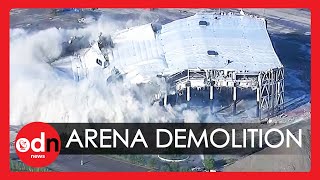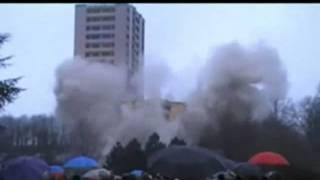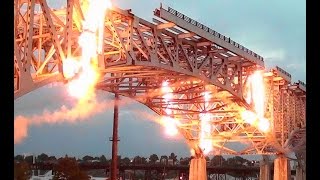Sunday, 21 December, 2025г.
















Где искать: по сайтам Запорожской области, статьи, видео ролики
пример: покупка автомобиля в Запорожье
Explosive Demolition Compilation: The Hanford Nuclear Site
With some good old fashioned non-explosive wrecking at the end.
The Hanford Site is a mostly decommissioned nuclear production complex operated by the United States federal government on the Columbia River in the U.S. state of Washington. The site has been known by many names, including: Hanford Project, Hanford Works, Hanford Engineer Works and Hanford Nuclear Reservation.
Established in 1943 as part of the Manhattan Project in Hanford, south-central Washington, the site was home to the B Reactor, the first full-scale plutonium production reactor in the world. Plutonium manufactured at the site was used in the first nuclear bomb, tested at the Trinity site, and in Fat Man, the bomb detonated over Nagasaki, Japan.
During the Cold War, the project expanded to include nine nuclear reactors and five large plutonium processing complexes, which produced plutonium for most of the more than 60,000 weapons built for the U.S. nuclear arsenal. Nuclear technology developed rapidly during this period, and Hanford scientists produced major technological achievements. Many early safety procedures and waste disposal practices were inadequate, and government documents have confirmed that Hanford's operations released significant amounts of radioactive materials into the air and the Columbia River.
The weapons production reactors were decommissioned at the end of the Cold War, and decades of manufacturing left behind 53 million US gallons (200,000 m3) of high-level radioactive waste stored within 177 storage tanks, an additional 25 million cubic feet (710,000 m3) of solid radioactive waste, and 200 square miles (520 km2) of contaminated groundwater beneath the site.
In 2011, the federal agency charged with overseeing the site, the US Department of Energy (DOE), emptied 149 single-shell tanks by pumping nearly all of the liquid waste out into 28 newer double-shell tanks. DOE later found water intruding into at least 14 single-shell tanks and that one of them had been leaking about 640 US gallons (2,400 l; 530 imp gal) per year into the ground since about 2010. In 2012, DOE discovered a leak also from a double-shell tank caused by construction flaws and corrosion in the bottom, and that 12 double-shell tanks have similar construction flaws. Since then, the DOE changed to monitoring single-shell tanks monthly and double-shell tanks every three years, and also changed monitoring methods.
In March 2014, the DOE announced further delays in the construction of the Waste Treatment Plant, which will affect the schedule for removing waste from the tanks. Intermittent discoveries of undocumented contamination have slowed the pace and raised the cost of cleanup.
Once I verified that all of the explosive demolition footage from the Hanford Site was in the public domain I jumped at the opportunity to bring together the best of many fantastic short clips, while removing the DOE contractor's branding from the beginning and end of each video. (They can have one shout-out, right here: Good work, CH2MHill, and thanks for documenting it.)
Enjoy!
https://en.wikipedia.org/wiki/Hanford_Site
~~~~~~
Producing What You Haven't Seen is immensely rewarding, but it's a full-time job and in the long run I can't do it without you.
Consistently producing the content you enjoy takes a tremendous amount of time and a non-trivial amount of money, and no matter how many views this channel gets I don't get a penny from YouTube.
So I have a simple ask: If you appreciate this content and look forward to more of it, click the link below and pledge whatever feels right to you.
All supporters get instant access to a video covering the collision of two F-16s at Nellis Air Force Base, and as the channel reaches its goals tons of incredible footage will be unlocked.
http://www.patreon.com/whatyouhaventseen
Thank you. And now back to your regularly unscheduled programming.
Теги:
demolition explosion building demolition explosive demolitions gone wrong building implosion extreme best building demolition top building implosion people are awesome explosive demolition how to demolish buildings demolish implode new york albany amazing video amazing satisfying demolition video implosions explosion oddly most satisfing videos satisfying compilations the most satisfying video
Похожие видео
Мой аккаунт


 У вашего броузера проблема в совместимости с HTML5
У вашего броузера проблема в совместимости с HTML5


